Comparison of Corrosion Performance of Extruded and Forged WE43 Mg Alloy
Abstract
:1. Introduction
2. Experiments and Methods
2.1. Material Preparation
2.2. Microstructural Characterization
2.3. Immersion Measurements
2.4. Electrochemical Measurements
3. Results
3.1. XRD Analyses and Microstructural Characterization
3.2. Immersion Test
3.2.1. Corrosion Morphology Characterization
3.2.2. Surface Film Characterization
3.2.3. Gravimetric Results
3.2.4. Hydrogen Evolution Results
3.3. Electrochemical Corrosion Behavior of WE43 Mg Alloy
3.3.1. EIS Analysis
3.3.2. Potential Dynamic Polarization Curves
4. Discussion
4.1. Different Microstructures of the Extruded and Forged WE43 Alloys
4.2. Different Corrosion Behaviors of the Extruded and Forged WE43 Alloyws
5. Conclusions
- (1)
- The extruded and forged WE43 have the same phase composition but different microstructures. The extruded WE43 alloy undergoes complete dynamic recrystallization, showing a uniform phase distribution. Due to the nonuniform segregation of rare earth elements, the forged WE43 alloy exhibits coarse grains and a larger phase size relative to the extruded WE43 alloy.
- (2)
- Different cathode sizes might lead to different corrosion behaviors, and the large second phase has higher electrochemical activity than the pearl-shaped second phase. A strong microcouple is formed between the large second phase and the Mg matrix, which causes severe local corrosion.
- (3)
- The surface film of the forged WE43 alloy fails in shorter time, while the surface film of the extruded WE43 alloy still maintains a good protective ability after a longer immersion time.
- (4)
- The extruded WE43 alloy exhibits better corrosion resistance than the forged WE43 alloy, which is attributed to the synergistic effect of the microgalvanic corrosion behavior and the formed surface film.
Author Contributions
Funding
Institutional Review Board Statement
Informed Consent Statement
Data Availability Statement
Conflicts of Interest
References
- Song, J.; She, J.; Chen, D.; Pan, F. Latest research advances on magnesium and magnesium alloys worldwide. J. Magnes. Alloy. 2020, 8, 1–41. [Google Scholar] [CrossRef]
- Ali, M.; Hussein, M.A.; Al-Aqeeli, N. Magnesium-based composites and alloys for medical applications: A review of mechanical and corrosion properties. J. Alloys Compd. 2019, 792, 1162–1190. [Google Scholar] [CrossRef]
- Ascencio, M.; Pekguleryuz, M.; Omanovic, S. An investigation of the corrosion mechanisms of WE43Mg alloy in a modified simulated body fluid solution: The effect of electrolyte renewal. Corros. Sci. 2015, 91, 297–310. [Google Scholar] [CrossRef]
- Hou, L.; Li, Z.; Zhao, H.; Pan, Y.; Pavlinich, S.; Liu, X.; Li, X.; Zheng, Y.; Li, L. Microstructure, Mechanical Properties, Corrosion Behavior and Biocompatibility of As-Extruded Biodegradable Mg-3Sn-1Zn-0.5Mn Alloy. J. Mater. Sci. Technol. 2016, 32, 874–882. [Google Scholar] [CrossRef]
- Kang, Y.; Du, B.; Li, Y.; Wang, B.; Sheng, L.; Shao, L.; Zheng, Y.; Xi, T. Optimizing mechanical property and cytocompatibility of the biodegradable Mg-Zn-Y-Nd alloy by hot extrusion and heat treatment. J. Mater. Sci. Technol. 2019, 35, 6–18. [Google Scholar] [CrossRef]
- Yang, P.; Ye, S.; Feng, B.; Liu, J.; Huang, S.; Liu, G.; Zhang, W.; Tang, W.; Zhu, S.; Zhang, S. Microgalvanic Corrosion of Mg-Ca and Mg-Al-Ca Alloys in NaCl and Na2SO4 Solutions. Materials 2021, 14, 7140. [Google Scholar] [CrossRef]
- Wu, J.; Wang, R.; Feng, Y.; Peng, C. Effect of hot rolling on the microstructure and discharge properties of Mg-1.6 wt% Hg-2 wt% Ga alloy anodes. J. Alloys Compd. 2018, 765, 736–746. [Google Scholar] [CrossRef]
- Sun, Y.; Li, W.; Shi, X.; Tian, L. A uniformly fine-grained Mg-Y-Nd-Zr magnesium alloy with simultaneously optimized strength and ductility processed by forging and ECAP. Mater. Res. Express 2020, 7, 116520. [Google Scholar] [CrossRef]
- Chang, J.W.; Duo, J.; Xiang, Y.Z.; Yang, H.Y.; Ding, W.J.; Peng, Y.H. Influence of Nd and Y additions on the corrosion behaviour of extruded Mg-Zn-Zr alloys. Int. J. Miner. Metall. Mater. 2011, 18, 203–209. [Google Scholar] [CrossRef]
- Zhang, J.; Liu, S.; Wu, R.; Hou, L.; Zhang, M. Recent developments in high-strength Mg-RE-based alloys: Focusing on Mg-Gd and Mg-Y systems. J. Magnes. Alloy. 2018, 6, 277–291. [Google Scholar] [CrossRef]
- Pan, H.; Ren, Y.; Fu, H.; Zhao, H.; Wang, L.; Meng, X.; Qin, G. Recent developments in rare-earth free wrought magnesium alloys having high strength: A review. J. Alloys Compd. 2016, 663, 321–331. [Google Scholar] [CrossRef]
- Chu, P.W.; Marquis, E.A. Linking the microstructure of a heat-treated WE43 Mg alloy with its corrosion behavior. Corros. Sci. 2015, 101, 94–104. [Google Scholar] [CrossRef]
- Xu, W.; Birbilis, N.; Sha, G.; Wang, Y.; Daniels, J.E.; Xiao, Y.; Ferry, M. A high-specific-strength and corrosion-resistant magnesium alloy. Nat. Mater. 2015, 14, 1229–1235. [Google Scholar] [CrossRef] [PubMed]
- Mraied, H.; Wang, W.; Cai, W. Influence of chemical heterogeneity and microstructure on the corrosion resistance of biodegradable we43 magnesium alloys. J. Mater. Chem. B 2019, 7, 6399–6411. [Google Scholar] [CrossRef]
- Li, X.; Qi, W.; Zheng, K.; Zhou, N. Enhanced strength and ductility of Mg-Gd-Y-Zr alloys by secondary extrusion. J. Magnes. Alloy. 2013, 1, 54–63. [Google Scholar] [CrossRef] [Green Version]
- Zeng, Z.; Stanford, N.; Davies, C.H.J.; Nie, J.F.; Birbilis, N. Magnesium extrusion alloys: A review of developments and prospects. Int. Mater. Rev. 2019, 64, 27–62. [Google Scholar] [CrossRef]
- You, S.; Huang, Y.; Kainer, K.U.; Hort, N. Recent research and developments on wrought magnesium alloys. J. Magnes. Alloy. 2017, 5, 239–253. [Google Scholar] [CrossRef]
- Liu, X.; Hu, W.; Le, Q.; Zhang, Z.; Bao, L.; Cui, J. Microstructures and mechanical properties of high performance Mg-6Gd-3Y-2Nd-0.4Zr alloy by indirect extrusion and aging treatment. Mater. Sci. Eng. A 2014, 612, 380–386. [Google Scholar] [CrossRef]
- Salandari-Rabori, A.; Zarei-Hanzaki, A.; Fatemi, S.M.; Ghambari, M.; Moghaddam, M. Microstructure and superior mechanical properties of a multi-axially forged WE magnesium alloy. J. Alloys Compd. 2017, 693, 406–413. [Google Scholar] [CrossRef]
- Gholami-Kermanshahi, M.; Neubert, V.D.; Tavakoli, M.; Pastorek, F.; Smola, B.; Neubert, V. Effect of ECAP Processing on Corrosion Behavior and Mechanical Properties of the ZFW MP Magnesium Alloy as a Biodegradable Implant Material. Adv. Eng. Mater. 2018, 20, 1800121. [Google Scholar] [CrossRef]
- Xia, X.; Wang, C.; Wu, Y.; Zhang, K.; Ma, M.; Yuan, B. Grain Refinement, Microstructure and Mechanical Properties Homogeneity of Mg-Gd-Y-Nd-Zr Alloy During Multidirectional Forging. J. Mater. Eng. Perform. 2018, 27, 5689–5699. [Google Scholar] [CrossRef]
- Liu, J.; Song, Y.; Shan, D.; Han, E.-H. Different Microgalvanic Corrosion Behavior of Cast and Extruded EW75 Mg Alloys. J. Electrochem. Soc. 2016, 163, C856–C863. [Google Scholar] [CrossRef] [Green Version]
- Przondziono, J.; Walke, W.; Hadasik, E.; Szala, J.; Wieczorek, J. Corrosion resistance tests of magnesium alloy WE43 after extrusion. Metalurgija 2013, 52, 243–246. [Google Scholar]
- Hu, Z.; Yin, Z.; Yin, Z.; Wang, K.; Liu, Q.; Sun, P.; Yan, H.; Song, H.; Luo, C.; Guan, H.; et al. Corrosion behavior characterization of as extruded Mg-8Li-3Al alloy with minor alloying elements (Gd, Sn and Cu) by scanning Kelvin probe force microscopy. Corros. Sci. 2020, 176, 108923. [Google Scholar] [CrossRef]
- Zhang, Y.; Gao, M.; Etim, I.P.; Tan, L.; Yang, K. Optimising the torsional properties and corrosion resistance of biodegradable WE43 Mg alloy by ECAP and subsequent ageing. Mater. Technol. 2020, 35, 402–410. [Google Scholar] [CrossRef]
- Li, J.; Yang, Y.; Deng, H.; Li, M.; Su, J.; Hu, F.; Xiong, X.; Peng, X. Microstructure and corrosion behavior of as-extruded Mg-6.5Li-xY-yZn alloys. J. Alloys Compd. 2020, 823, 153839. [Google Scholar] [CrossRef]
- Feng, Y.J.; Wei, L.; Chen, X.B.; Li, M.C.; Cheng, Y.F.; Li, Q. Unexpected cathodic role of Mg41Sm5 phase in mitigating localized corrosion of extruded Mg-Sm-Zn-Zr alloy in NaCl solution. Corros. Sci. 2019, 159, 108133. [Google Scholar] [CrossRef]
- ASTM B951-2011; Standard Practice for Codification of Unalloyed Magnesium and Magnesium-Alloys, Cast and Wrought. ASTM International: West Conshohocken, PA, USA, 2011.
- Luo, K.; Zhang, L.; Wu, G.; Liu, W.; Ding, W. Effect of Y and Gd content on the microstructure and mechanical properties of Mg-Y-RE alloys. J. Magnes. Alloy. 2019, 7, 345–354. [Google Scholar] [CrossRef]
- Yu, Z.; Xu, C.; Meng, J.; Kamado, S. Microstructure evolution and mechanical properties of a high strength Mg-11.7Gd-4.9Y-0.3Zr (wt%) alloy prepared by pre-deformation annealing, hot extrusion and ageing. Mater. Sci. Eng. A 2017, 703, 348–358. [Google Scholar] [CrossRef]
- Nie, J.F.; Muddle, B.C. Characterisation of strengthening precipitate phases in a Mg-Y-Nd alloy. Acta Mater. 2000, 48, 1691–1703. [Google Scholar] [CrossRef]
- Yu, S.; Liu, C.; Gao, Y.; Jiang, S.; Yao, Y. Microstructure, texture and mechanical properties of Mg-Gd-Y-Zr alloy annular forging processed by hot ring rolling. Mater. Sci. Eng. A 2017, 689, 40–47. [Google Scholar] [CrossRef]
- Chen, J.; Song, Y.; Shan, D.; Han, E.H. Influence of alloying elements and microstructure on the formation of hydrotalcite film on Mg alloys. Corros. Sci. 2015, 93, 90–99. [Google Scholar] [CrossRef]
- Feng, B.; Liu, G.; Yang, P.; Huang, S.; Qi, D.; Chen, P.; Wang, C.; Du, J.; Zhang, S.; Liu, J. Different role of second phase in the micro-galvanic corrosion of WE43 Mg alloy in NaCl and Na2SO4 solution. J. Magnes. Alloy. 2021. [Google Scholar] [CrossRef]
- Shah, S.S.A.; Wu, D.; Wang, W.H.; Chen, R.S. Microstructural evolution and mechanical properties of a Mg-Gd-Y alloy processed by impact forging. Mater. Sci. Eng. A 2017, 702, 153–160. [Google Scholar] [CrossRef]
- Grimm, M.; Lohmüller, A.; Singer, R.F.; Virtanen, S. Influence of the microstructure on the corrosion behaviour of cast Mg-Al alloys. Corros. Sci. 2019, 155, 195–208. [Google Scholar] [CrossRef]
- Yin, S.; Duan, W.; Liu, W.; Wu, L.; Yu, J.; Zhao, Z.; Liu, M.; Wang, P.; Cui, J.; Zhang, Z. Influence of specific second phases on corrosion behaviors of Mg-Zn-Gd-Zr alloys. Corros. Sci. 2020, 166, 108419. [Google Scholar] [CrossRef]
- Chu, P.W.; Le Mire, E.; Marquis, E.A. Microstructure of localized corrosion front on Mg alloys and the relationship with hydrogen evolution. Corros. Sci. 2017, 128, 253–264. [Google Scholar] [CrossRef]
- Zhang, J.; Jiang, B.; Yang, Q.; Huang, D.; Tang, A.; Pan, F.; Han, Q. Role of second phases on the corrosion resistance of Mg-Nd-Zr alloys. J. Alloys Compd. 2020, 849, 156619. [Google Scholar] [CrossRef]
- Saikrishna, N.; Pradeep Kumar Reddy, G.; Munirathinam, B.; Ratna Sunil, B. Influence of bimodal grain size distribution on the corrosion behavior of friction stir processed biodegradable AZ31 magnesium alloy. J. Magnes. Alloy. 2016, 4, 68–76. [Google Scholar] [CrossRef] [Green Version]
- Ralston, K.D.; Birbilis, N.; Davies, C.H.J. Revealing the relationship between grain size and corrosion rate of metals. Scr. Mater. 2010, 63, 1201–1204. [Google Scholar] [CrossRef]
- Luo, Y.; Deng, Y.; Guan, L.; Ye, L.; Guo, X. The microstructure and corrosion resistance of as-extruded Mg-6Gd-2Y-(0-1.5)Nd-0.2Zr alloys. Mater. Des. 2020, 186, 108289. [Google Scholar] [CrossRef]
- Toscano, D.; Behravesh, S.B.; Shaha, S.K.; Jahed, H.; Williams, B. Characterization of closed-die forged AZ31B under pure axial and pure shear loading. Int. J. Fatigue 2020, 139, 105754. [Google Scholar] [CrossRef]
- Salandari-Rabori, A.; Zarei-Hanzaki, A.; Abedi, H.R.; Lecomte, J.S.; Khatami-Hamedani, H. Micro and macro texture evolution during multiaxial forging of a WE43 magnesium alloy. J. Alloys Compd. 2018, 739, 249–259. [Google Scholar] [CrossRef]
- Taheri, M.; Danaie, M.; Kish, J.R. TEM Examination of the Film Formed on Corroding Mg Prior to Breakdown. J. Electrochem. Soc. 2014, 161, C89–C94. [Google Scholar] [CrossRef]


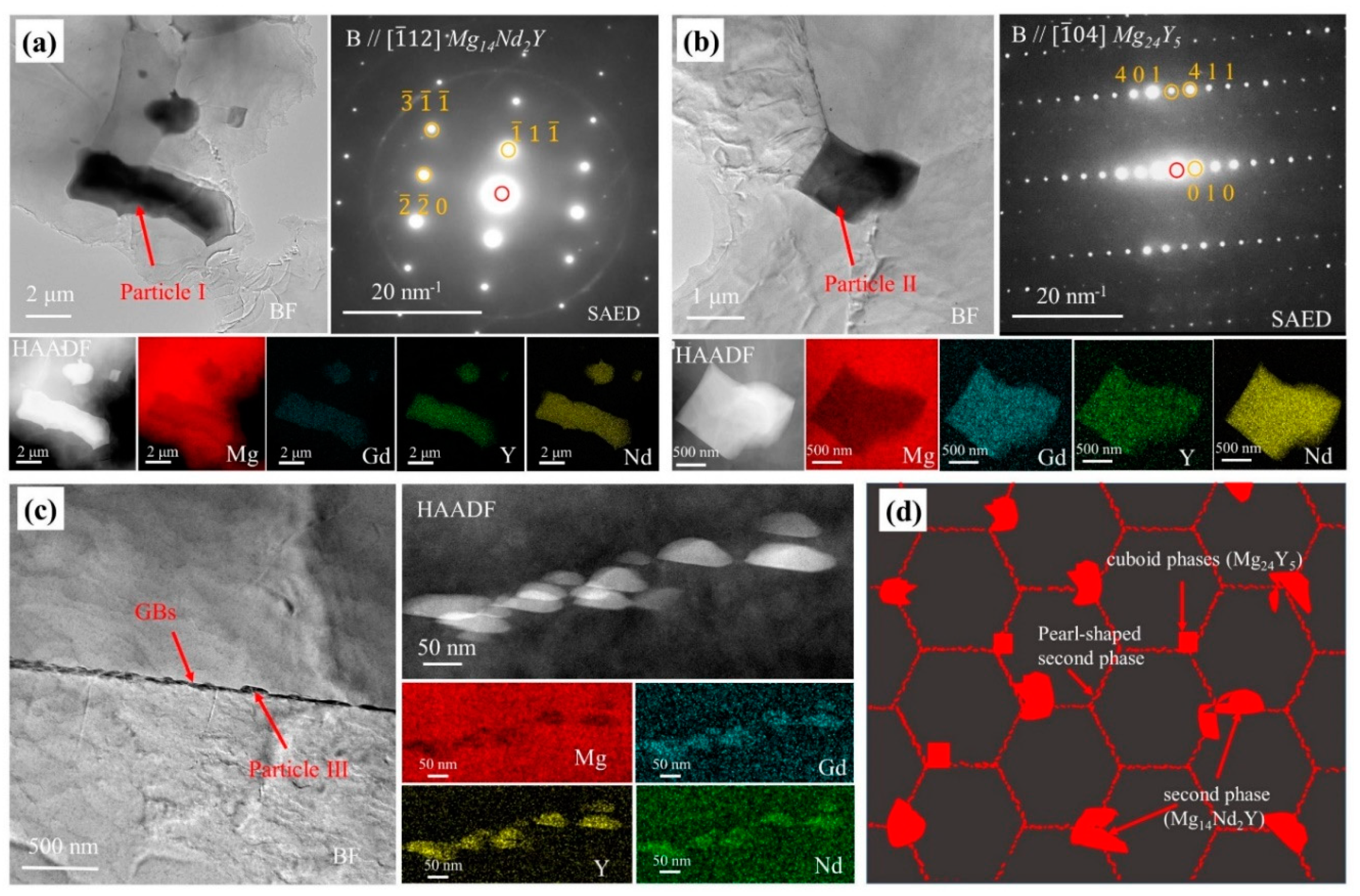
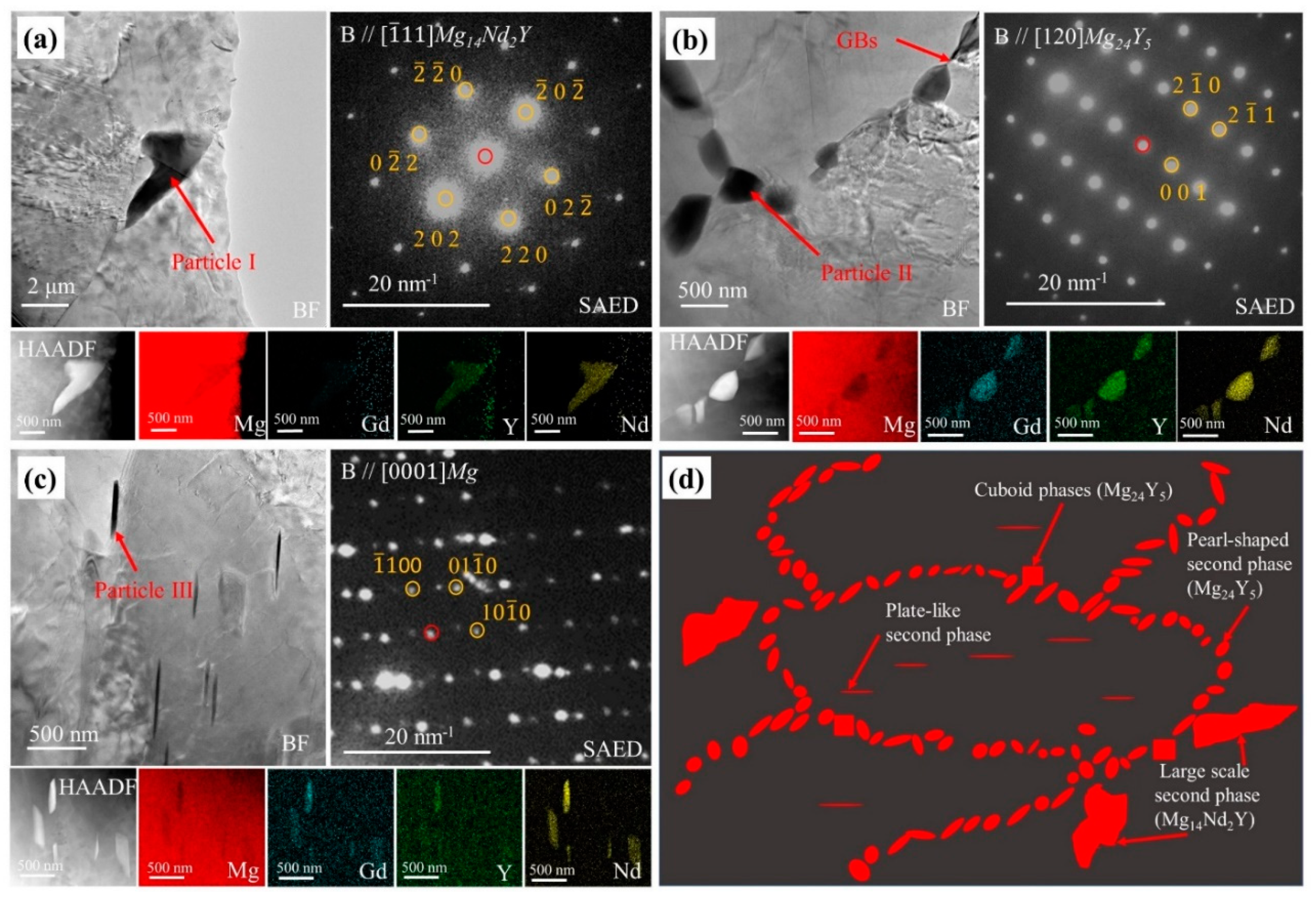
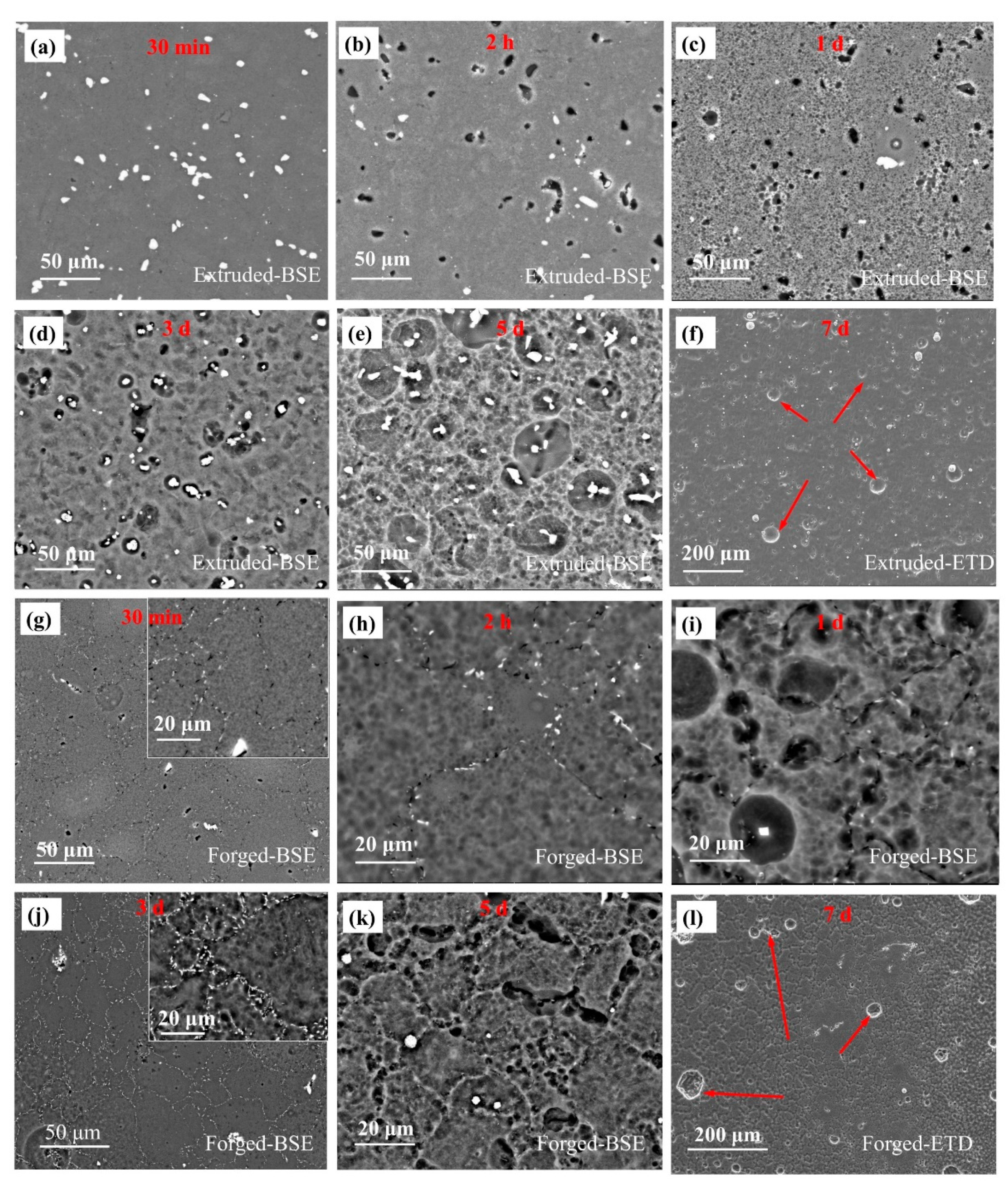
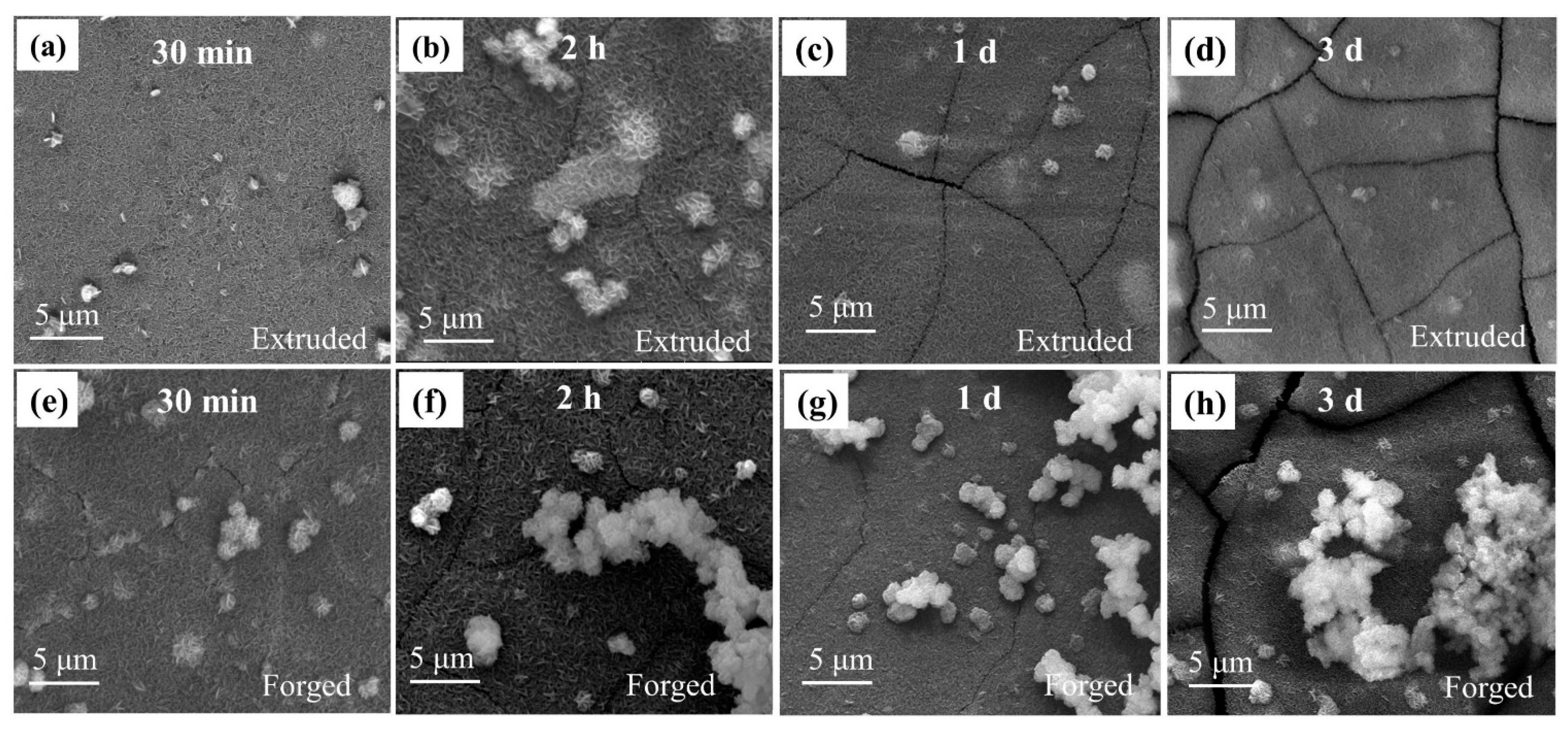
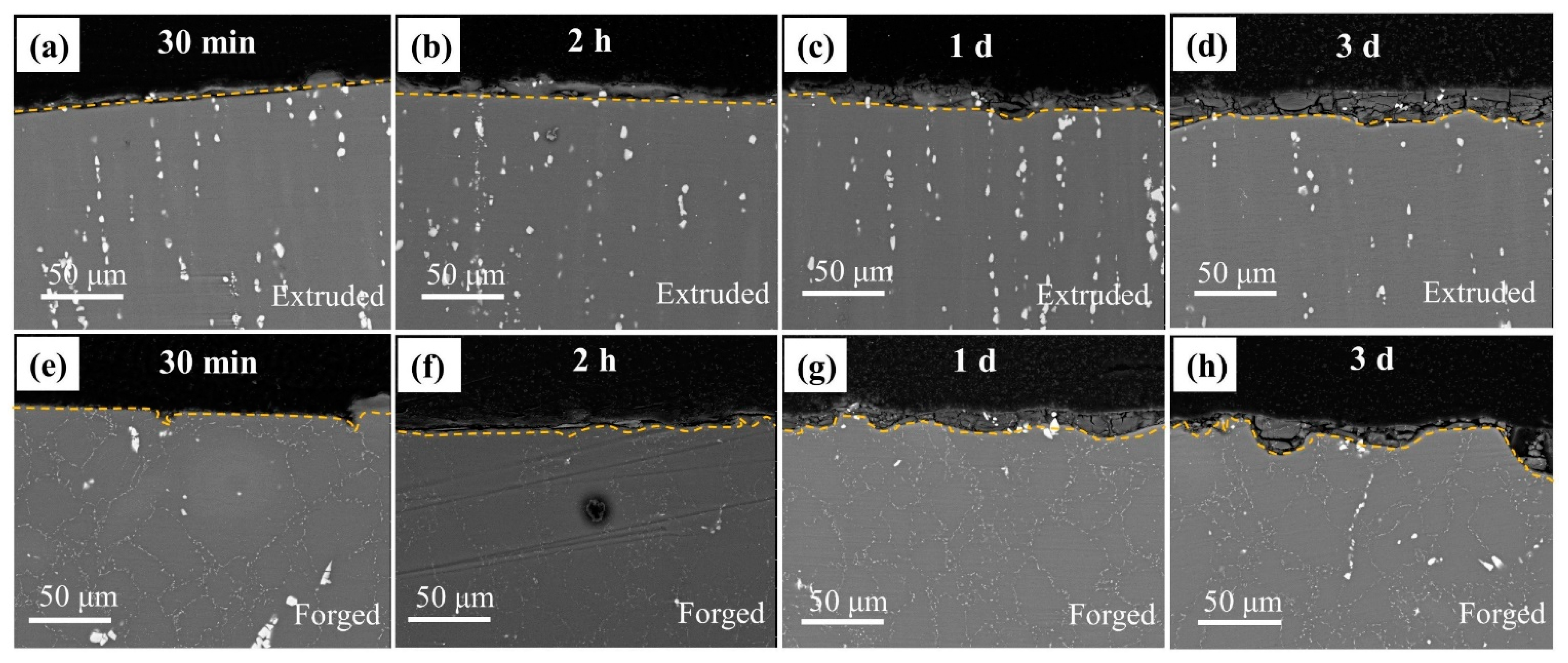
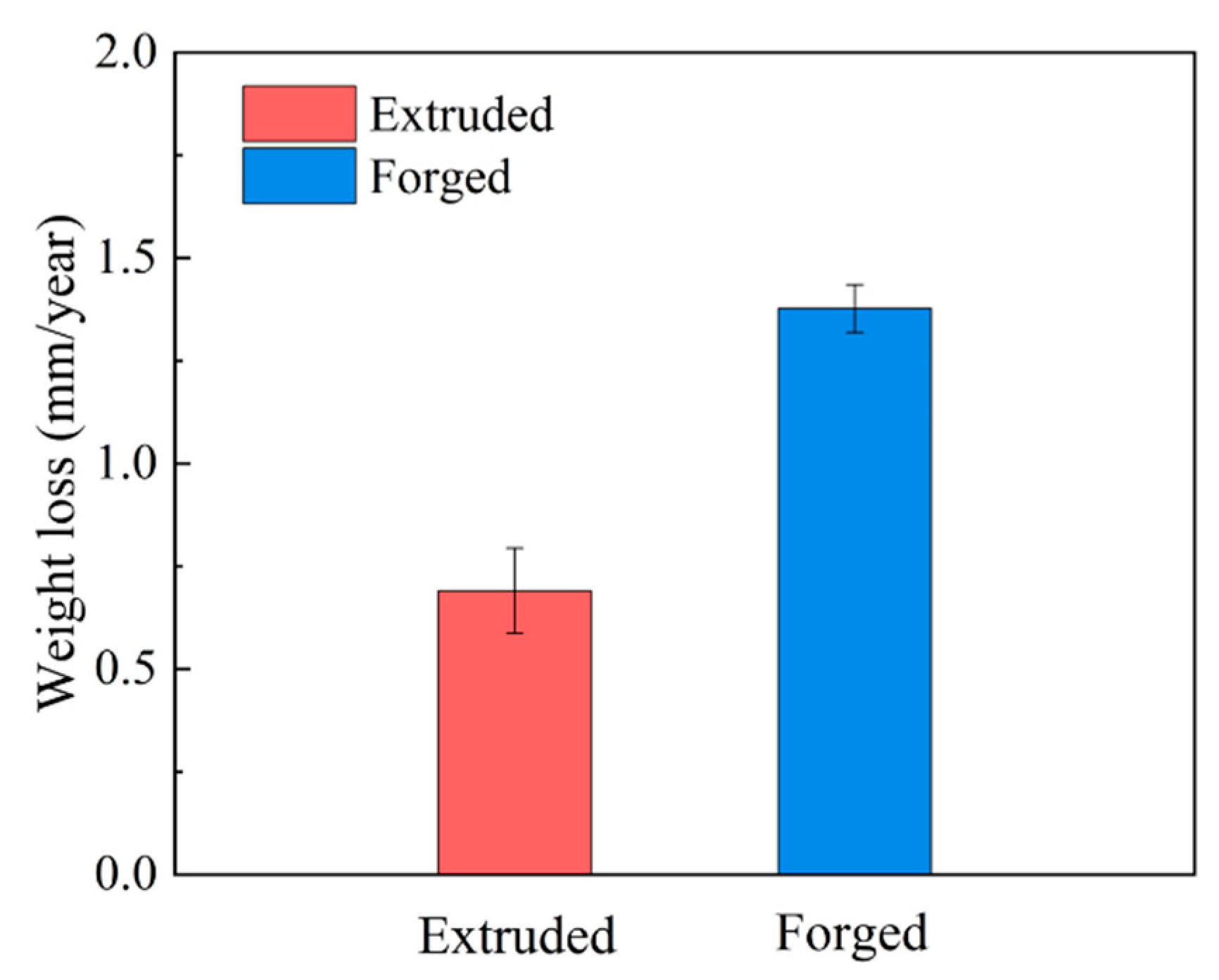
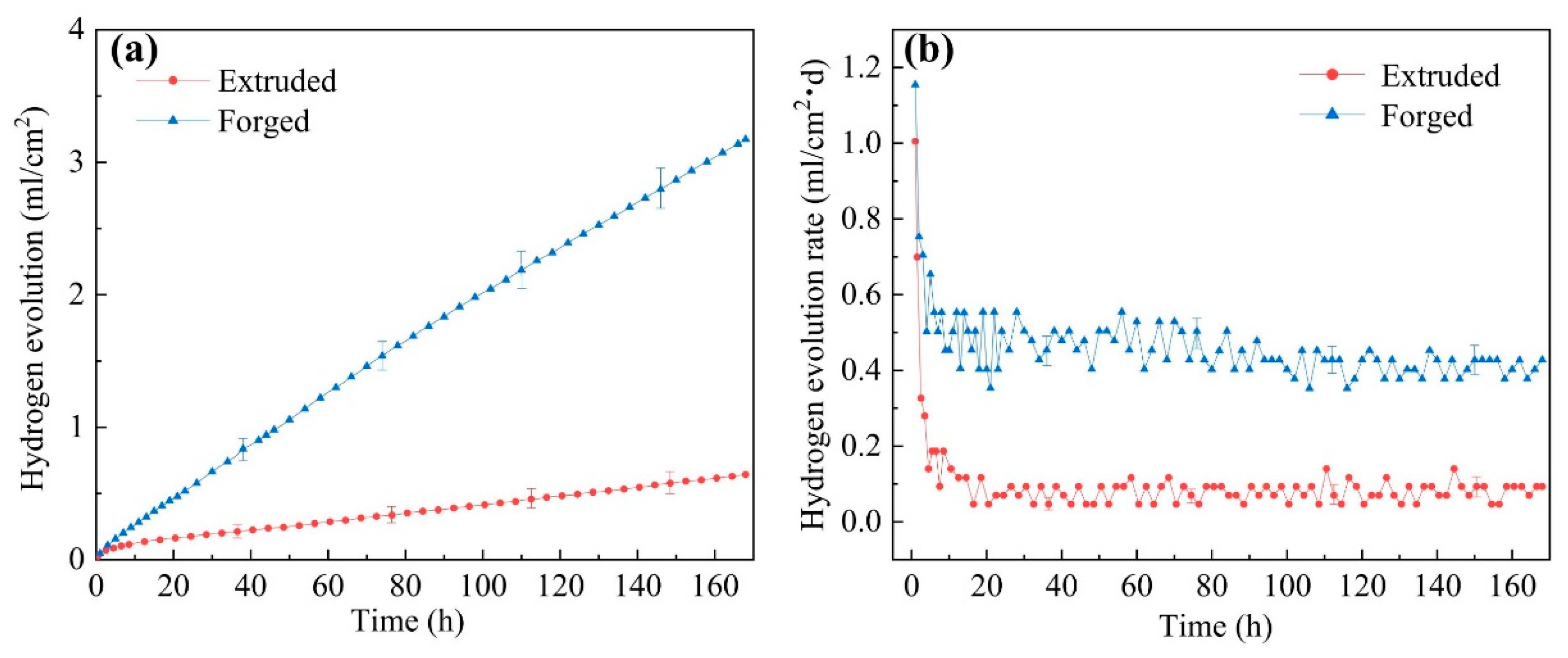

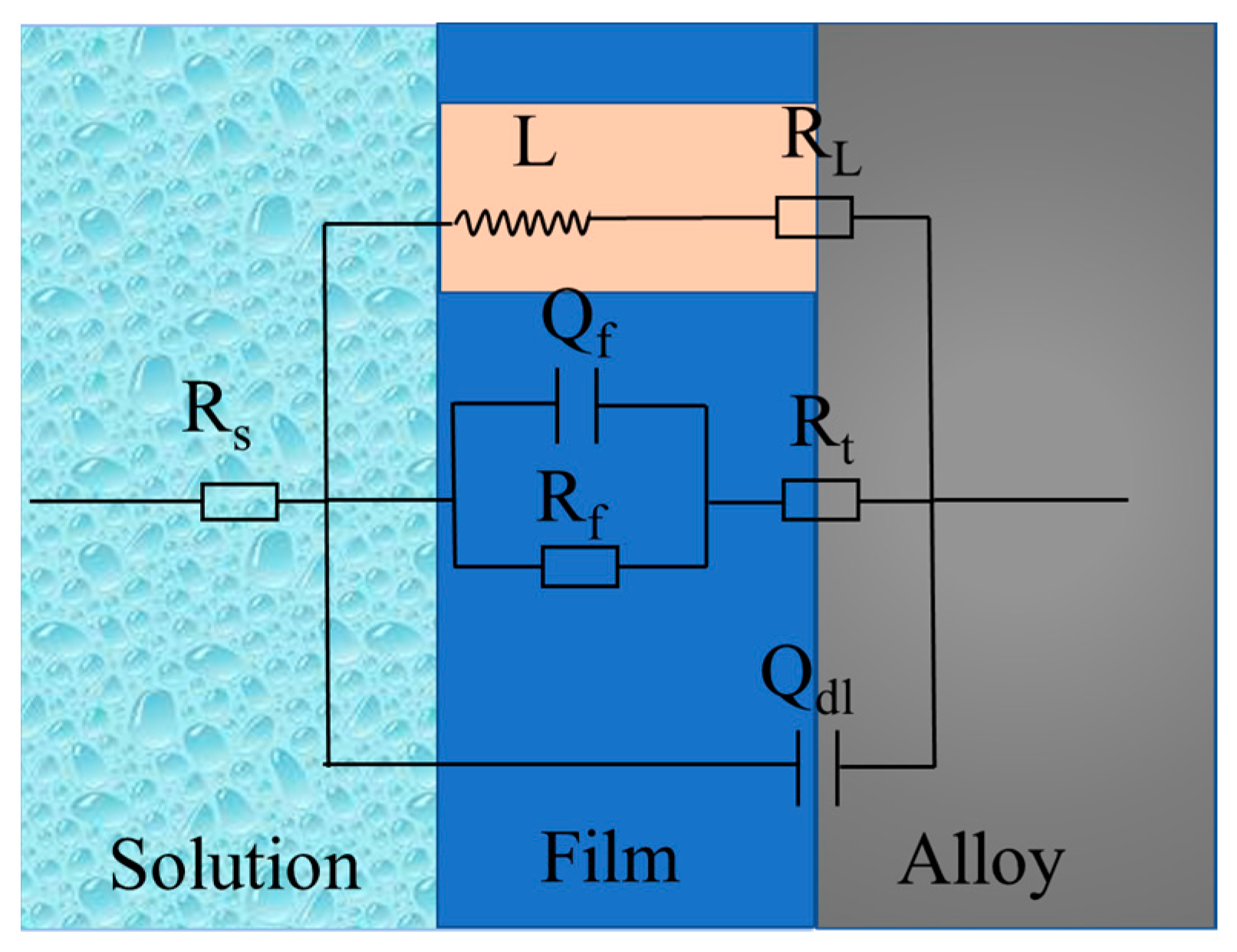
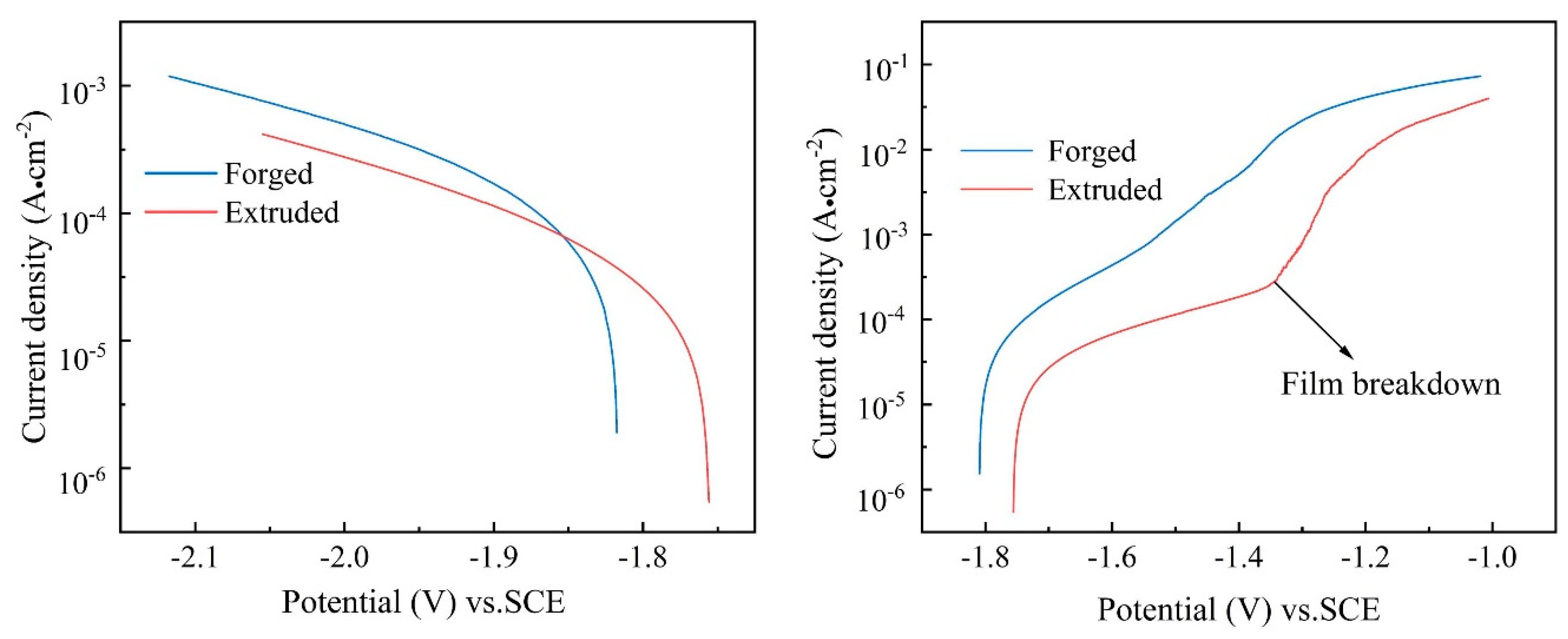
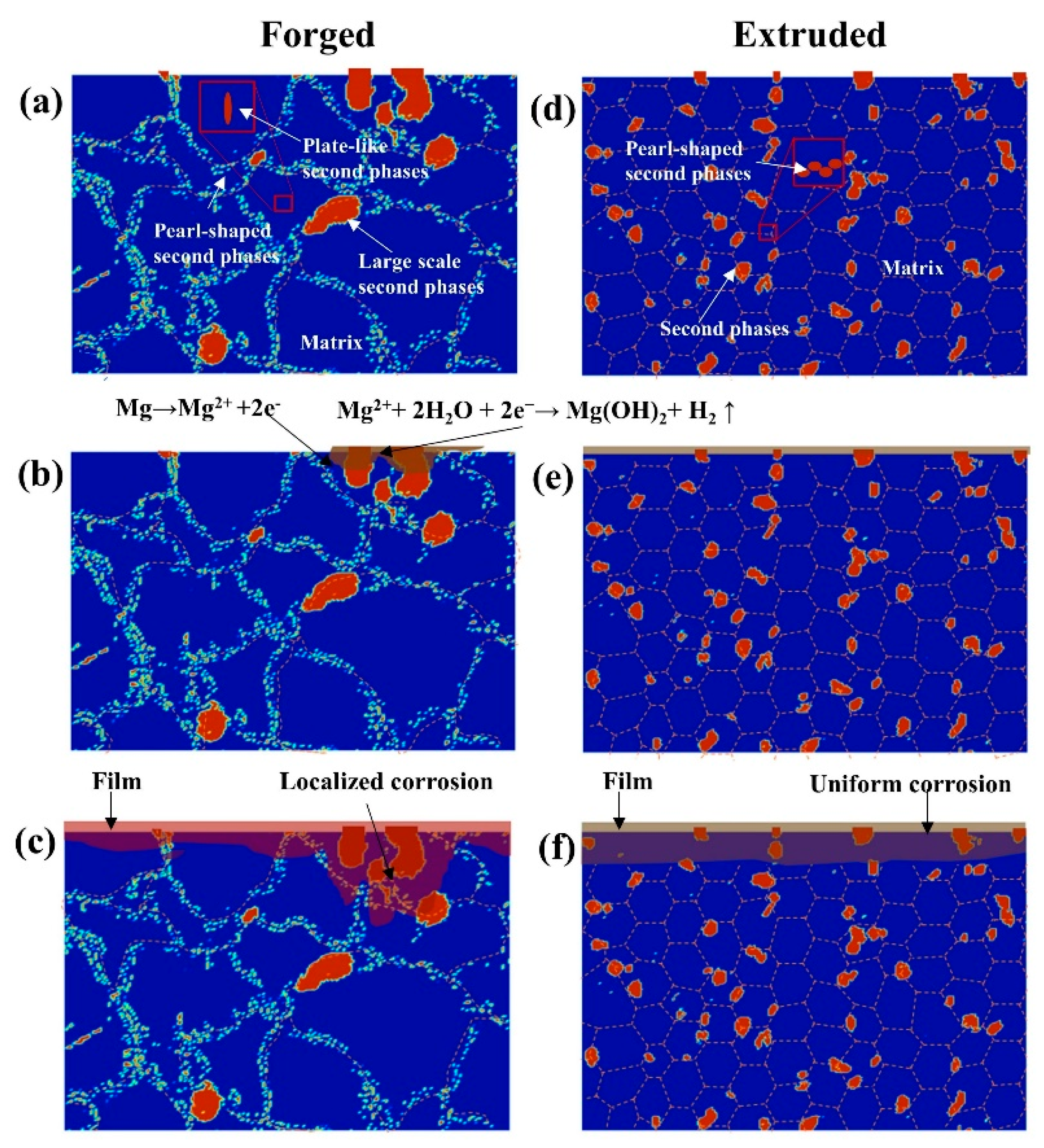
| State | Particle | Mg (at%) | Y (at%) | Nd (at%) | Gd (at%) | Zr (at%) |
|---|---|---|---|---|---|---|
| Extruded | I | 86.47 | 4.78 | 8.13 | 0.37 | 0.25 |
| II | 87.57 | 5.55 | 6.34 | 0.35 | 0.19 | |
| III | 95.84 | 1.93 | 1.33 | 0.41 | 0.49 | |
| α-Mg | 98.05 | 1.14 | 0.21 | 0.22 | 0.39 | |
| Forged | I | 87.22 | 5.77 | 5.9 | 0.67 | 0.44 |
| II | 86.51 | 6.45 | 5.87 | 0.84 | 0.33 | |
| III | 91.86 | 2.45 | 4.76 | 0.35 | 0.58 | |
| α-Mg | 98.20 | 1.17 | 0.26 | 0.20 | 0.17 |
| Status | Rs Ω cm2 | Qdl (μF cm−2 sn−1) | ndl | Rt Ω cm2 | Qf (μF cm−2 sn−1) | nf | Rf Ω cm2 | RL Ω cm2 | L H cm−2 | χ2 |
|---|---|---|---|---|---|---|---|---|---|---|
| Extruded | 11.81 | 1.71 × 10−3 | 0.70 | 909.6 | 1.40 × 10−5 | 0.93 | 1247 | 5051 | 1.16 × 104 | 1.83 × 10−4 |
| Forged | 11.28 | 1.63 × 10−5 | 0.92 | 682.7 | 2.45 × 10−3 | 0.66 | 549 | 1225 | 8.21 × 104 | 2.76 × 10−4 |
| State | Ecorr (VSCE) | Icorr (μA cm−2) | Bc (mV decade−1) |
|---|---|---|---|
| Forged | −1.82 ± 0.2 | 140.3 ± 5 | 319.8 ± 5 |
| Extruded | −1.75 ± 0.1 | 33.1 ± 2 | 265.9 ± 3 |
Publisher’s Note: MDPI stays neutral with regard to jurisdictional claims in published maps and institutional affiliations. |
© 2022 by the authors. Licensee MDPI, Basel, Switzerland. This article is an open access article distributed under the terms and conditions of the Creative Commons Attribution (CC BY) license (https://creativecommons.org/licenses/by/4.0/).
Share and Cite
Liu, G.; Xu, J.; Feng, B.; Liu, J.; Qi, D.; Huang, W.; Yang, P.; Zhang, S. Comparison of Corrosion Performance of Extruded and Forged WE43 Mg Alloy. Materials 2022, 15, 1622. https://doi.org/10.3390/ma15051622
Liu G, Xu J, Feng B, Liu J, Qi D, Huang W, Yang P, Zhang S. Comparison of Corrosion Performance of Extruded and Forged WE43 Mg Alloy. Materials. 2022; 15(5):1622. https://doi.org/10.3390/ma15051622
Chicago/Turabian StyleLiu, Guonan, Jilei Xu, Baojing Feng, Jinhui Liu, Dongqing Qi, Wenzhan Huang, Peixu Yang, and Shaojun Zhang. 2022. "Comparison of Corrosion Performance of Extruded and Forged WE43 Mg Alloy" Materials 15, no. 5: 1622. https://doi.org/10.3390/ma15051622






